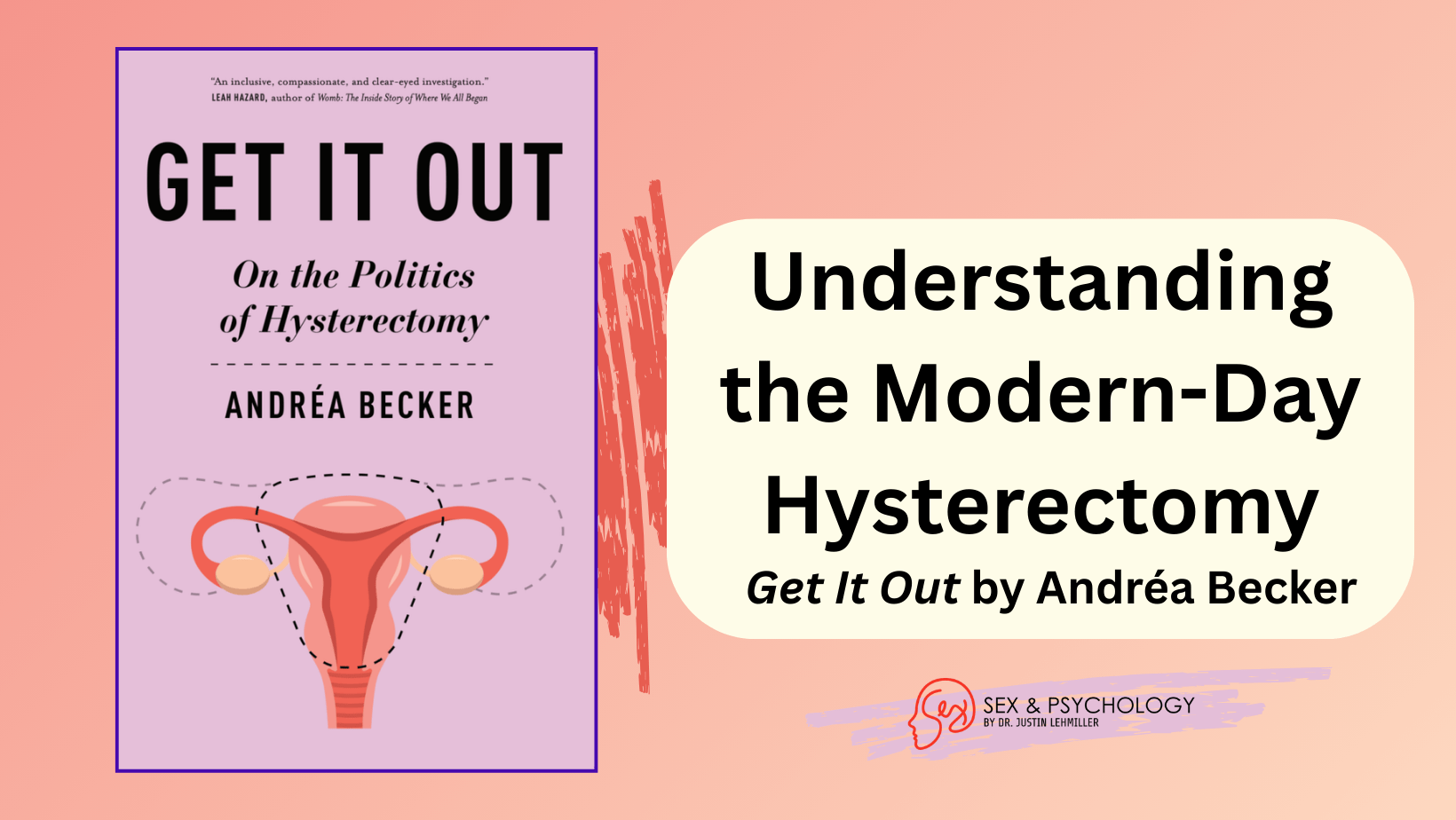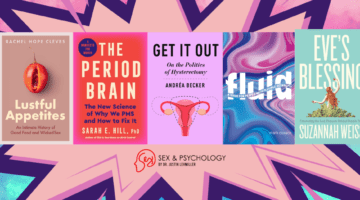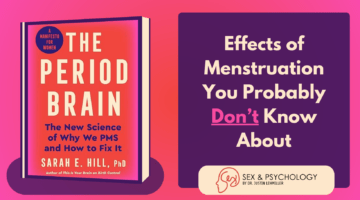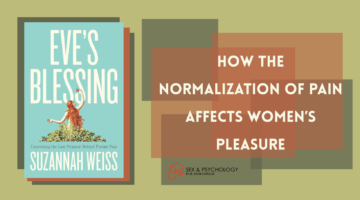Understanding the Modern-Day Hysterectomy
August 27, 2025 by Emily Mendelson
A hysterectomy is a medical procedure that involves the removal of the uterus (and oftentimes the cervix). There are a number of different kinds of hysterectomies, as well as a number of different reasons that someone might undergo the procedure. For example, a total hysterectomy removes the uterus and cervix, but leaves the ovaries, but a total hysterectomy with bilateral salpingo-oophorectomy removes the uterus, cervix, ovaries, and fallopian tubes.
In this post, we’re diving into a new book that investigates the political nature of the hysterectomy and hear a little bit from the author about the book’s key themes.
Prevalence of Hysterectomy in the United States
Hysterectomy may be performed for a variety of reasons, such as cancer treatment, severe fibroids, endometriosis, and pregnancy prevention. It is also sometimes performed as part of gender-affirming care. In the United States, hysterectomy is a fairly common surgical procedure. In fact, the CDC reported in 2021 that over one-third of women in the United States undergo hysterectomy by age 65.
This data, however, also reveals how hysterectomy is performed disproportionately across demographic groups. For example, disabled women are more likely to have undergone hysterectomy compared to non-disabled women (20.9% to 14.1%, respectively). These figures suggest that, in some cases, hysterectomy may still be forced onto individuals as a form of sterilization (historically, coerced sterilization was commonplace as a means of controlling certain populations, including the disabled).
However, while some are compelled to undergo hysterectomy, others who actually want the procedure often find it difficult to access, with their choice being contested by medical professionals, insurance agencies, and society writ large. For example, many cases exist of young women who have pursued hysterectomy because they do not want children but have been denied access to the procedure.
Get It Out: On the Politics of Hysterectomy
Get It Out, a new book by Dr. Andréa Becker, investigates the politics of hysterectomy in modern-day life. At its core, the book considers what it means to actually be able to choose to undergo a hysterectomy, especially in a country where abortion rights are limited, medical care is not a guaranteed right, and motherhood is forwarded as a pinnacle of womanhood. Get It Out contains five content chapters, and takes a “a trans- inclusive approach [to reveal] additional insight into how gender shapes all clinical encounters, as patients experience contradictory recommendations and barriers to care for the same procedure based on whether they are cis or trans” (p. 7).
Of the five chapters of the book, the first chapter discusses the history of the hysterectomy, and chapters two through five center the experiences of those interviewed for the book. These individuals had a chronic reproductive illnesses and/or identified as trans or nonbinary, and spoke to topics such as why someone might want a hysterectomy (chapter 2), the ability to “choose” a hysterectomy (chapter 3), how people feel about hysterectomy (chapter 4), and navigating access to hysterectomy (chapter 5).
We were fortunate to have Andréa answer some questions for us about Get It Out to discuss the inspiration behind the book and some important considerations when it comes to discussing modern-day hysterectomy.
Q&A With Dr. Andréa Becker
What was the inspiration behind undergoing a project focused on individuals’ experiences with hysterectomy?
The uterus has long been used as a cultural battleground. Though only the size of a fist, the uterus has been forced to hold fights over a woman’s place in society, the meaning of motherhood, and a woman’s right to control her body. All sorts of pundits, politicians, doctors, and regular joes have opinions about birth control, how many babies a woman should have, whether she should be able to terminate a pregnancy, and whether this organ and “women’s hormones” altogether disqualify someone from holding political office. So what might it meant to remove this organ which for so long has been a stand in for women’s “otherness” and inferiority?
Not to mention, there is a vast silence on hysterectomy despite how incredibly common it is. One in five people who are born with a uterus will have it removed by the time they are in their sixties—a statistic that was one in three when I began this project and one which never ceases to shock the person who asks why I study hysterectomy. I also noticed how hysterectomy is overwhelmingly understood as something that is categorically bad and to be avoided at all costs. Historians, theorists, activists, and medical practitioners largely discuss hysterectomy as an unnecessary procedure forced upon women by “hyster-happy” doctors. A quick Google search for “hysterectomy book,” for instance, provides hair-raising results like The Hysterectomy Hoax, The Castrated Woman, and No More Hysterectomies. And within my own field of sociology, the only book devoted to understanding hysterectomy has the forlorn title Am I Still a Woman?
And yet, by hearing from one of the 100 hysterectomy seekers in my book and delving into the history of this procedure, the story of hysterectomy grows more complicated. While we rarely read about this in news headlines, many people want a hysterectomy, choose a hysterectomy, and are happy to have had a hysterectomy. As my interviewees explained, people might want a hysterectomy for a number of reasons, whether to find freedom from one of the many illnesses that affect the uterus and ovaries or to affirm their gender. In many ways, a hysterectomy can be understood as a form of self care. This is especially the case because the modern hysterectomy is unrecognizable from its earlier forms–it’s now largely regarded as minimally invasive, typically outpatient, and leaves behind 3-5 tiny abdominal scars. Yet we continue to talk about hysterectomy, and doctors continue to approach the surgery as unilaterally devastating. My book digs into why we think of it as so awful, how people actually feel about it, and what a zoomed-in look at hysterectomy can teach us about the broader state of healthcare and social inequality.
Something I appreciate about the book is the effort you made to include the experiences of trans and/or nonbinary individuals. Can you talk a little bit about why this effort was so important to you?
Trans identities and gender affirming healthcare are under attack. Over the past few years, we have seen an immense backlash to the progress we have collectively made in the realms of trans rights, including attempts to ban gender affirming care for minors and even to designate it as “child abuse.” Scholars tend to think of trans rights as separate from reproductive rights, but the fate of both are inextricable. Politicians use the same playbook to limit reproductive autonomy as they do to limit bodily and gender freedom. Attacks on both are an attempt to redraw–and tighten–the boundaries around gender roles, a woman’s place in society, the centrality of the [white middle class] family. The last time we saw such a massive, simultaneous attack on trans rights and women’s rights was the rise of the Third Reich after a period of progress in Weimar Germany. Medical doctor and sexologist Magnus Hirschfield established a trans clinic and trans medical research journal in the 1890’s (that’s right–trans healthcare is older than antibiotics), and he was labeled by Hitler as “the most dangerous Jew in Germany.”
We now know, of course, that all of this was part and parcel to the eugenicist, pronatalist, Naz agenda. It is absolutely critical to defend trans rights alongside reproductive rights, now more than ever.
How do you understand your participants to be the real “experts” when it comes to the topic of hysterectomies?
Medicine tends to pit providers against patients as experts versus consumers. The reality is that patients have immense embodied knowledge, as well. People who have been sidelined by the healthcare system tend to invest in understanding their symptoms and in seeking treatments and relief. Though women’s pain–especially women of color’s pain–has been historically and continuously minimized and normalized, the people I interviewed came to understand that their symptoms were not “normal periods.” They banded together in community, including across various social media platforms, to share lists of “good doctors,” scripts to use in clinical encounters to get better care, and even shared current biomedical research findings that they could share with their doctors. I call these actions in the book as characteristics of “the rowdy patient.” It is part of a much longer tradition of patients collectively demanding that the medical system take them seriously–harkng back to the women’s health movement in the early 20th century, the HIV/AIDS movement in the 70’s and 80’s, and current fights against obstetrics racism. Patients–especially women and trans people–know their bodies and want to live healthy, pain-free lives, if only their doctors listen to them.
One of the central themes in the book is whether undergoing a hysterectomy can actually be framed as a “choice.” What are some of the factors that constrain the extent to which a hysterectomy is truly an elective procedure?
When we talk about “the right to choose” conversations tend to be limited to abortion–to be able to exert agency in terminating a single pregnancy. Yet bodily and reproductive autonomy span far beyond the termination of a pregnancy. Full right to choose also means that a healthcare system is equipped to help you take care of your body. We refer to the uterus, ovaries, and cervix as the “reproductive system” or “reproductive organs” but people want to keep these organs healthy and pain-free beyond their use for gestating and delivering a pregnancy. We have known about endometriosis–a disease that impacts 10% of people with these organs–since the early 20th century for instance, yet still we can only diagnose it via surgery and there is no known permanent cure. As I say over and over in the book, to have a uterus in a medical system built for cis women having babies often means being pushed to want hysterectomy and then being told to wait. People with chronic pain and bleeding often choose a hysterectomy as a mode of self care and for many people it brings a lot of relief. Yet this choice is constrained. Would they choose this surgery if there was adequate attention, funding, and research devoted to promoting the health and wellbeing of the uterus, ovaries, and cervix? Would they have wanted a hysterectomy if they hadn’t spent years of their lives being told their pain was a normal part of having a uterus? It’s these broader structural and cultural conditions that ultimately render a hysterectomy constrained, even if it’s very much wanted and met with joy.
A hysterectomy as part of gender affirming care is also constrained, despite being recognized as essential care and one that brings joy and relief to those who want it. There is limited research on how the hormones involved in gender affirming care impacts the uterus, ovaries, and cervix, and therefore conflicting information about whether someone taking hormones needs a hysterectomy. There’s long been a fear within the medical community that long-term use of HRT will lead to cancers in these organs, commonly leading doctors to suggest a hysterectomy to patients, and many trans and nonbinary patients opting into this surgery as a preventative measure even if having a uterus doesn’t necessarily bother them. At the same time, many of the transmasc people I spoke to would have liked to preserve their fertility, but the additional costs of gametes retrieval and cryopreservation on top of the hysterectomy was too burdensome. In many cases, their doctors didn’t even discuss fertility preservation, which is a stark contrast to women’s experiences. In a context of structural medical transphobia, limited research, and lack of funds, a hysterectomy as part of gender affirming care likewise becomes a constrained choice.
To learn more about Get It Out and Andréa’s work, you can click here to visit her website. You can also find Andréa on Instagram, Bluesky, and Twitter.
If you have a sex question of your own, record a voicemail at speakpipe.com/sexandpsychology to have it answered on the blog or the podcast.
Want to learn more about Sex and Psychology? Click here for more from the blog or here to listen to the podcast. Follow Sex and Psychology on Facebook, Twitter (@JustinLehmiller), Bluesky, or Reddit to receive updates. You can also follow Dr. Lehmiller on YouTube and Instagram.
Image made with Canva.
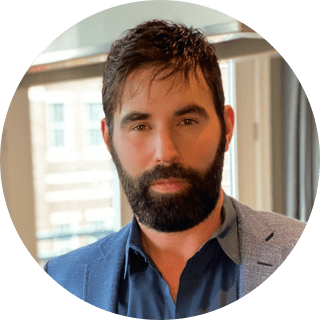
Dr. Justin Lehmiller
Founder & Owner of Sex and PsychologyDr. Justin Lehmiller is a social psychologist and Research Fellow at The Kinsey Institute. He runs the Sex and Psychology blog and podcast and is author of the popular book Tell Me What You Want. Dr. Lehmiller is an award-winning educator, and a prolific researcher who has published more than 50 academic works.
Read full bio >